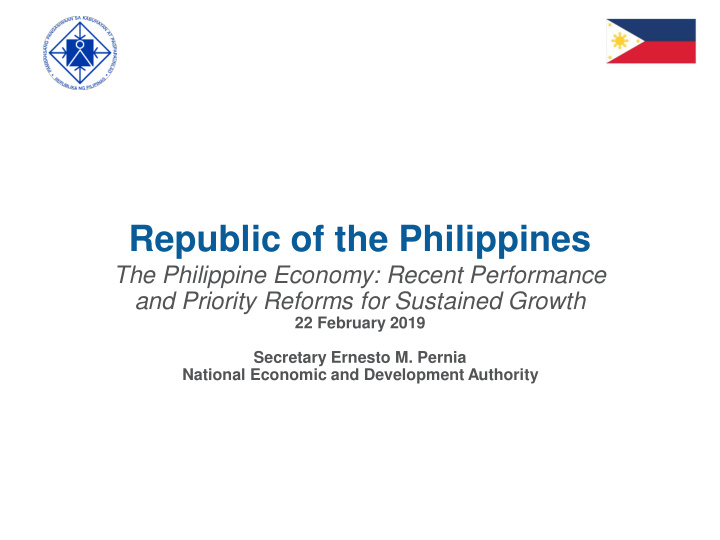



Republic of the Philippines The Philippine Economy: Recent Performance and Priority Reforms for Sustained Growth 22 February 2019 Secretary Ernesto M. Pernia National Economic and Development Authority
PH Economic Growth in Sharp Upward Trajectory Gross Domestic Product (GDP) Growth Rates at Constant 2000 Prices (%) 6.2% 6.3% 2010-2018 4.5% % FY 2018 2.8% 2.0% 2000-2009 1990-1999 8 1980-1989 6 4 6.7% 2 FY 2017 0 1980 1981 1982 1983 1984 1985 1986 1987 1988 1989 1990 1991 1992 1993 1994 1995 1996 1997 1998 1999 2000 2001 2002 2003 2004 2005 2006 2007 2008 2009 2010 2011 2012 2013 2014 2015 2016 2017 Page 1|50 -2 -4 -6 -8 Source: Philippine Statistics Authority (PSA) 2
PH Among the Fastest Growing Major Economies in Asia China 6.6% India Vietnam 7.7 % 7.1% (Q1-Q3) Philippines 6.2% Thailand 4.1% Page 1|50 Malaysia 4.7% Indonesia 5.2% 3
Private Investment and Government Spending Co-pilot Economic Growth ECONOMIC PERFORMANCE FY (Growth Rate in % ) 2018 6.2 GROSS DOMESTIC PRODUCT By Industrial Origin Agriculture, Fishery and Forestry 0.8 Industry 6.8 Manufacturing 4.9 Services 6.6 By Expenditure Household Final Consumption 5.6 Gov’t Final Consumption 12.8 Capital Formation 13.9 Fixed Capital Formation 14.0 Construction 15.1 Exports 11.5 Imports 14.5
Rising Foreign Net Equity Investments in Manufacturing Net Equity (in USD million) Percent Share to Net Equity by Industry (%) Others 3,500 3,285.3 5.9% Financial and 4.1% 3,000 Insurance Activities [CELLRANGE] 2,592.1 7.5% 2,500 Construction 1,997.5 [CELLRANGE] 2,000 35.5% 15.5% [CELLRANGE] [CELLRANGE] 11.5% Real Estate 1,500 [CELLRANGE] 4.9% Activities [CELLRANGE] 13.5% [CELLRANGE] 1,000 Manufacturing Page 1|50 42.1% [CELLRANGE] 51.5% [CELLRANGE] 500 [CELLRANGE] [CELLRANGE] [CELLRANGE] 6.5% [CELLRANGE] Electricity, Gas, 0 2016 2017 Jan - Nov 2018 Steam and (Amount in USD mn) Airconditioning Supply -500 Source: Bangko Sentral ng Pilipinas (BSP) Note: Figures may not add up due to rounding 5
Despite the uptrend this year, inflation is expected to normalize in the medium term FY 2017 FY 2018 PHILIPPINES Headline Inflation 5.2 2.9 Food 6.8 3.0 Non-Food 3.4 2.6 NATIONAL CAPITAL REGION Headline Inflation 5.5 3.7 Food 6.9 5.5 Non-Food 4.5 2.8 Page 1|50 AREAS OUTSIDE NCR Headline Inflation 5.1 2.7 Food 6.9 2.5 Non-Food 3.2 2.5 6
The Outlook: Bright Prospects The Philippines is expected to remain one of the fastest-growing major economies in Asia 7.5 2017 2018F 2019F 7.3 7.1 6.9 6.8 6.7 6.7 6.6 6.6 6.5 6.2 6.2 5.9 5.1 5.1 5.1 4.7 4.6 4.6 3.9 3.9 3.7 3.8 3.6 3.5 2.9 2.5 Page 1|50 World India Vietnam China Philippines Indonesia Malaysia Thailand Singapore Output Source: IMF-WEO October 2018, IMF-WEO Update, January 2019; Actual 2018 GDP for 7 Philippines, China, and Vietnam
Potential Risks to Growth EXTERNAL Negative investor Inward looking E X T E R N A L Normalizing sentiment policies leading to monetary policy towards emerging tariff increases and of advanced markets trade tensions economies Build up of financial Easing of sector risks and global growth excessive credit growth DOMESTIC Delays in infra Restrictive Weak projects and employment consumer logistics protection legislation sentiment Page 1|50 bottleneck Natural Agricultural hazards supply bottlenecks Delayed Security risks passage of 2019 national budget
Sustaining/Accelerating Economic Growth Filipinos are among the youngest in Asia Demographic Windows in Asia Japan 1965 1995 Singapore 1980 2015 South Korea 1990 2015 Thailand 1995 2020 Vietnam 2005 2035 Indonesia 2010 2055 Malaysia 2010 2045 India 2015 2050 Myanmar 2015 2055 Cambodia 2025 2055 Philippines 2025 2070 1960 1970 1980 1990 2000 2010 2020 2030 2040 2050 2060 2070 Page 1|50 Source: United Nations *Demographic window is defined as the period when population under 15 years old drops below 30% and population over 65 years old is less than 15%
Sustaining/Accelerating Economic Growth Push for Key Policy Reforms Fully implement Responsible Put in place the Parenthood and Reproductive National ID system Health Law Fully implement Ease of Doing Rice Tariffication Business Law Page 1|50 Further trim Foreign Investment Negative List 10
Updated Public Investment Program 2017-2022* By Theme (PhP Billion) [CATEGORY [CATEGORY NAME][VALUE] NAME] ([PERCENTAGE]) [VALUE] [CATEGORY ([PERCENTAGE]) NAME] [VALUE] ([PERCENTAGE]) 9,581 [CATEGORY NAME] Programs and [VALUE] ([PERCENTAGE]) Projects [CATEGORY NAME] PHP9.26 [VALUE] ([PERCENTAGE]) trillion T otal Investment [CATEGORY Page 1|50 NAME], [VALUE] Requirement ([PERCENTAGE]) *Based on the submission of Agencies in the PIPOL System, validated by NEDA Secretariat as of December 14, 2018, and for confirmation by appropriate inter-agency bodies .
Estimated Impact of Increased Public Infrastructure Spending Employment, in hundred thousands 2,000 6 Additional Employment, in hundred thousands 1,800 Contribution to Economic Growth (%) 5 1,600 1,400 4 1,200 1,000 3 800 2 600 400 Page 1|50 1 200 0 0 2017 2018 2019 2020 2021 2022
Accelerating Infrastructure Development of the Updated Public Investment Program (PIP) 2017- 2022* Number of Infrastructure Projects by Region (As of December 2018) Nationwide 170 Nationwide 170 Interregional 68 Interregional 68 Region II 221 Region I 491 CAR 255 Region III 418 NCR 743 Region IV-A 302 Region V 359 Region IV-B 371 Region VIII 384 Region VI 506 Region VII 211 Region XIII 259 Page 1|50 Region IX 244 Region X 282 ARMM 1,845 Region XI 322 Region XII 142 Legend
Republic of the Philippines The Philippine Economy: Recent Performance and Priority Reforms for Sustained Growth 22 February 2019 Secretary Ernesto M. Pernia National Economic and Development Authority
Recommend
More recommend